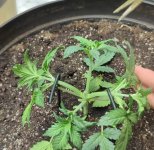aCBD
Well-known member
The green sponges are an eyecatcher.Lemon Cherry Cookies Auto by Fast Buds (Day 11)
View media item 18723527
@aCBD I thought about what you said and I followed your advice. I didn't want to use a towel but I put a few kitchen sponges inside cups. They soak moisture really well. Humidity didn't increase much but +4% is still a progressI will have to wash them with soap every few days to make sure that there is no nasty stuff growing on that
I have a different dilema now: I'm not sure if I should train this strainhaha... Here is a thing: Fast Buds claims that this strain should grow between 80 and 120 cm - however autoflowers might grow smaller depending on a few conditions. Distance between the surface of the pot and cobs is 95 cm. They also claim that it's a very fast strain... should I train it then or just let it grow as it is?
Originally I was thinking about topping (I would have to do it soon), to stratch side branches with hooks as wide as possible. If it was a photoperiodic strain I wouldn't have any doubts what to do, but becasue it's an autoflower (that is supposed to flower fast) I just don't know man...

You can get some more humidity if you fill the glass some more and put the sponges on a string so that they're only emerged half and the other half gets some wind. Good that you think about changing them.

If your first idea was to top the plant and train it accordingly, you should do that. Listen to your gut.

Don't have experience with autos but when i see what @bibi40 is doing, you don't need to hold back.
Happy growing








